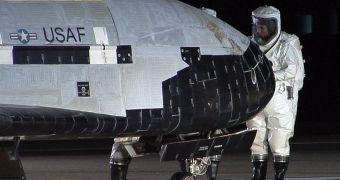The US Air Force (USAF) Rapid Capabilities Office is operating the X-37B unmanned spacecraft, which were developed by Boeing Phantom Works. The second such vehicle to fly to space has reached 270 days of continuous operations in low-Earth orbit today.
This is an impressive milestone because this is precisely how long the spacecraft is designed to last in the harsh and demanding conditions of space. Any amount of time it spends in LEO beyond today is a bonus for both the USAF and Boeing, experts say.
The secretive Orbital Test Vehicle-2 (OTV2) was launched on March 5, from the Cape Canaveral Air Force Station (CCAFS), in Florida. It was encapsulated in the upper stage of an Atlas V delivery system, and managed to reach orbit safely.
It threads in the footsteps of OTV1, which remained in space for 224 days, between April 22 and December 3, 2010. The new flight has already exceeded its predecessor by more than a month, and will most likely continue to do so for at least a little while longer.
According to Pentagon Air Force Press Desk USAF Major Tracy Bunko, the second X-37B prototype was launched to space for a 9-month mission, whose conclusion is now drawing near, Space reports. “It's still up there, so we're close to that now,” Bunko explains.
The USAF is extremely interested in the capabilities this spacecraft has to offer, since it has a payload bay that could conceivably be outfitted with surveillance, monitoring and spy equipment, in addition to scientific measurement suites and other payloads.
In other words, the X-37B offers a highly versatile and adaptable platform for a wide range of applications, while at the same time proving the capability to remain in space for prolonged periods of time. Currently, this is only possible on the International Space Station (ISS).
Scientists could, for example, use the spacecraft to send experiments to LEO, for medium- to long-term stays. Since the vehicle can reenter Earth's atmosphere and land on its own, whatever samples researchers send will be returned to them safely.
Boeing Phantom Works developed the vehicle as a miniaturized, robotic version of the space shuttle, so the X-37B has many of the capabilities their larger, manned counterparts did. However, it remains too small to be used for manned spaceflight.
The company is currently considering the development of larger versions of the space plane, which could conceivably be used to send astronauts to low-Earth orbit, and potentially the ISS.

 14 DAY TRIAL //
14 DAY TRIAL //